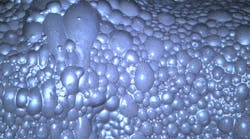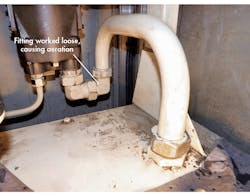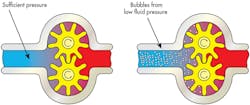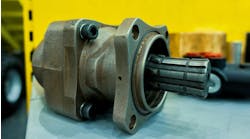Cavitation or Aeration? You Can Hear the Difference!
This file type includes high resolution graphics and schematics when applicable.
Cavitation is the formation and collapse of air cavities in liquid. When hydraulic fluid is pumped from a reservoir, pressure drops in the suction line to the pump. Despite what many people believe, the fluid is not sucked into the pump. Rather, it is pushed into the pump by atmospheric pressure (as shown in the left-hand illustration).
The movement of the rotating elements—gears, in this case, but the same applies to pistons and vanes—causes a drop in pressure at the suction line. The resulting pressure difference between the reservoir and the pump inlet causes the fluid to move from the higher pressure in the reservoir to the lower in the pump’s suction line. As long as the pressure difference is sufficient and the flow path is clear, the operation goes smoothly, but anything that reduces the inlet flow can cause problems. Whenever the pump cannot get enough fluid to fill its inlet chamber, cavitation occurs (as shown in the right-hand illustration).
Hydraulic oil contains approximately 9% of dissolved air. When the oil cannot flow into the pump fast enough to match pump’s intake volume, air is pulled out of the oil. The air bubbles travel into the pump, and when they reach an area of relatively high pressure, they collapse (implode). The resulting shock waves cause a steady, high-pitched whining sound and damage to the insides of the pump.
Causes of Cavitation
Fluid velocity is inversely proportional to the size of the hydraulic line. Most pumps have a suction line that is larger than the pressure line. This is done to keep inlet velocity low, making it very easy for oil to enter the pump. Any blockage, such as a plugged suction strainer or filter, can cause the pump to cavitate. A contaminated suction strainer is the most common cause of cavitation, simply because it is hidden deep within the oil in the reservoir.
One of our consultants was called to a plant in Georgia that had changed five pumps on a machine’s hydraulic system within a week. The first thing millwrights noticed was a high-pitched whining sound that was occurring every 20 to 30 sec. They had changed the suction line, and although a suction strainer was shown on the schematic, none was found in the line. The machine was then shut down and the reservoir drained to be cleaned. Guess what was found in the reservoir? The suction strainer, which had been floating around in the oil, occasionally blocked the suction pipe to the pump.
A plugged breather cap is another common occurrence. It can cause the pressure in the reservoir to drop as fluid level falls. Suction pressure at the pump becomes very low to compensate for this, causing bubbles to form.
As an example, a hose ruptured on a lathe at a plywood plant in Oregon, resulting in a loss of 150 gallons of oil from the reservoir. After the hose was changed, a lubrication technician removed one of the breather caps to refill the reservoir. A shift change occurred while he was filling the tank, so a second-shift technician took over. Once the reservoir was refilled, the second technician installed a pipe plug on the threads where the breather cap originally had been. The result was that one of the pumps on the unit failed due to cavitation within a few hours after startup. After losing a second pump within 24 hours, the pipe plug on the breather opening was discovered.
Extreme temperatures also can lead to cavitation. For example, high fluid temperatures can allow bubbles to form when the fluid is at low pressure. As the bubbles enter the pump, they collapse, causing cavitation. On the other hand, low temperatures can increase the oil’s viscosity, hindering the oil from flowing into the pump. (Oils with a high viscosity index resist this tendency, but because these oils cost more, they are not as widely used as standard fluids.) Therefore, most hydraulic systems should not be started up with the oil any colder than 40°F and should not be put under load until the oil is at least 70°F.
If the drive speed is too high for the pump used, adequate fluid volume cannot be delivered to the through its suction port, so cavitation occurs. Also, if the pump is mounted above the level of the hydraulic fluid in the reservoir, atmospheric pressure may be insufficient to deliver enough fluid to the pump inlet—again, causing cavitation. Systems operating high above sea level are especially susceptible to this condition due to the lower atmospheric pressure found at these elevations.
This file type includes high resolution graphics and schematics when applicable.
Aeration: a Different Scenario
This file type includes high resolution graphics and schematics when applicable.
Aeration occurs whenever outside air enters the suction inlet of the pump. This produces a sound that is more erratic than that of cavitation; the whining sound may be augmented by a sound similar to marbles or gravel rattling around inside the pump. In addition, oil in the reservoir may exhibit excessive foaming. Air in the oil can cause sluggishly operation and can damage the pump and other system components.
Pressure in the suction line is lower than that of the atmosphere, so any leaks in the suction line will not leak oil; instead, air will leak in. If you suspect an air leak, squirt oil on all the fittings and connections in the suction line. If the sound of aeration stops briefly, you have found your leak. An ultrasonic gun also can be used to detect leaks.
This condition was found when one of our consultants was asked to diagnose several pump failures on a hydraulic system at an automotive manufacturing plant. When he arrived at the machine, our consultant heard an erratic high-pitched sound. He also noticed several fittings in the suction line, as shown in the photo. He asked a millwright to squirt oil from a bottle around all the fittings in the suction line. When squirted on the fitting identified in the photo, the pump momentarily quieted down.
In this case, these fitting had vibrated loose after 12 years on the machine. However, improperly tightened or aligned fittings in the suction line can result from inexperienced or inattentive personnel working on hydraulic systems. Whenever work has been performed, check all of the fittings to make sure they are properly aligned and tightened to their specified torque.
Also, a leak in the shaft seal can cause aeration by allowing air to enter the low-pressure section of the pump from the atmosphere. If you suspect a bad shaft seal, spray some shaving cream around the seal. If the seal is leaking, voids in the shaving cream will develop as air enters the pump. This problem came to light when I was called to a paper mill, where foam came out of a log-kicker’s hydraulic reservoir shortly after the machine’s fixed-displacement pump was started. After performing the shaving cream test, I knew the shaft seal was badly worn. Upon further inspection, I found the pump elastomeric coupling was worn, causing wear on the shaft seal.
Incorrect shaft rotation may not be an issue with all pumps, but some will aerate the fluid if their input shaft is rotated in the wrong direction. Most pumps have a direction of rotation indicated on the pump housing. If it is shown on a sticker, the sticker may be removed when the pump is rebuilt. Always check the part number of a new pump to be installed with the old pump. A number or letter designation usually indicates whether a pump requires clockwise or counter-clockwise rotation. If you are unsure, remove the outlet line of the pump and secure it into a container. For safety's sake, never hold this line. Momentarily jog the electric motor. If the pump is rotating in the correct direction, oil will flow out of the outlet port.
Finally, the fluid level in the reservoir should never drop to more than 2 in. above the suction line inlet. If so, a vortex can form—much like when draining a bathtub. This introduces air into the suction line, resulting in aeration.
Summary
When troubleshooting hydraulic pump problems, make the visual and sound checks first, as these are the easiest to do. Remember that aeration and cavitation produce different sounds. Many times you can determine the cause of the problem before the first wrench is turned.
Jack Weeks is a consultant with GPM Hydraulic Consulting, Monroe, Ga.
This file type includes high resolution graphics and schematics when applicable.




